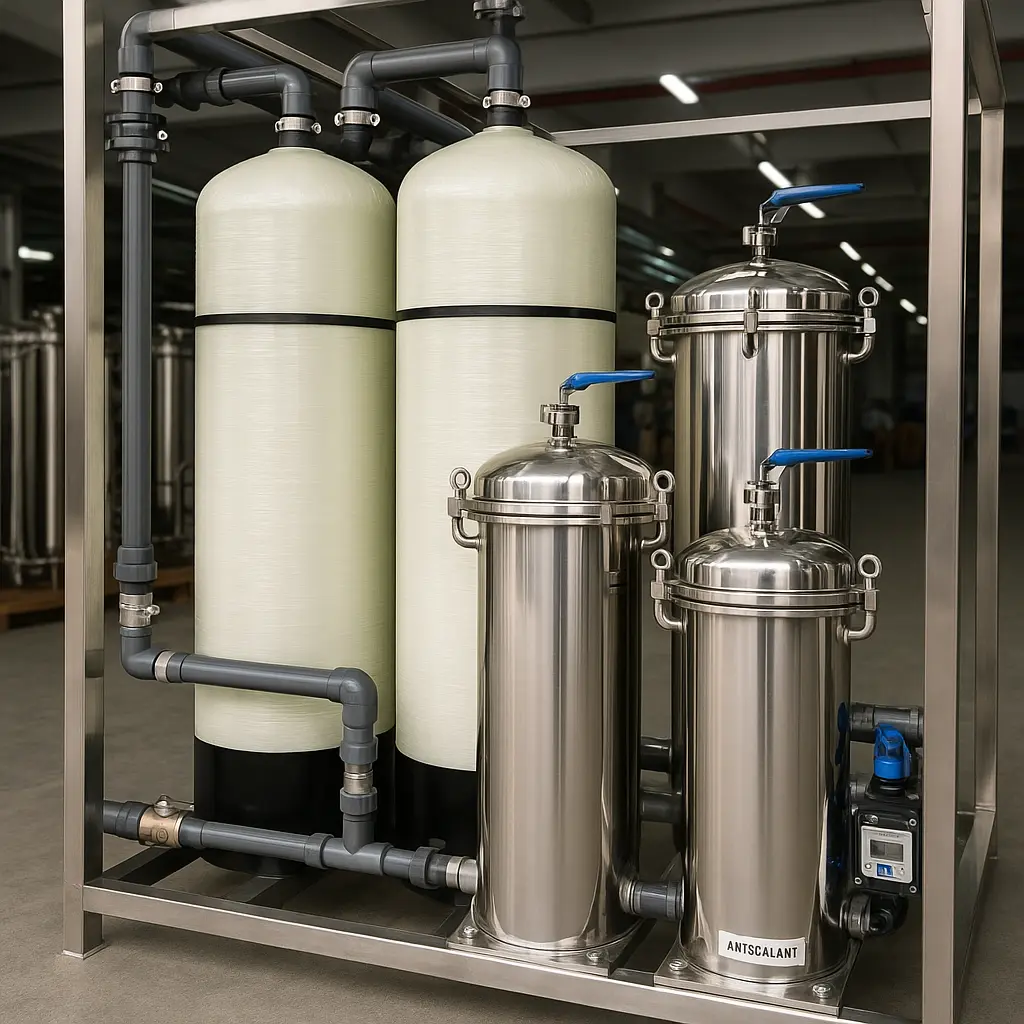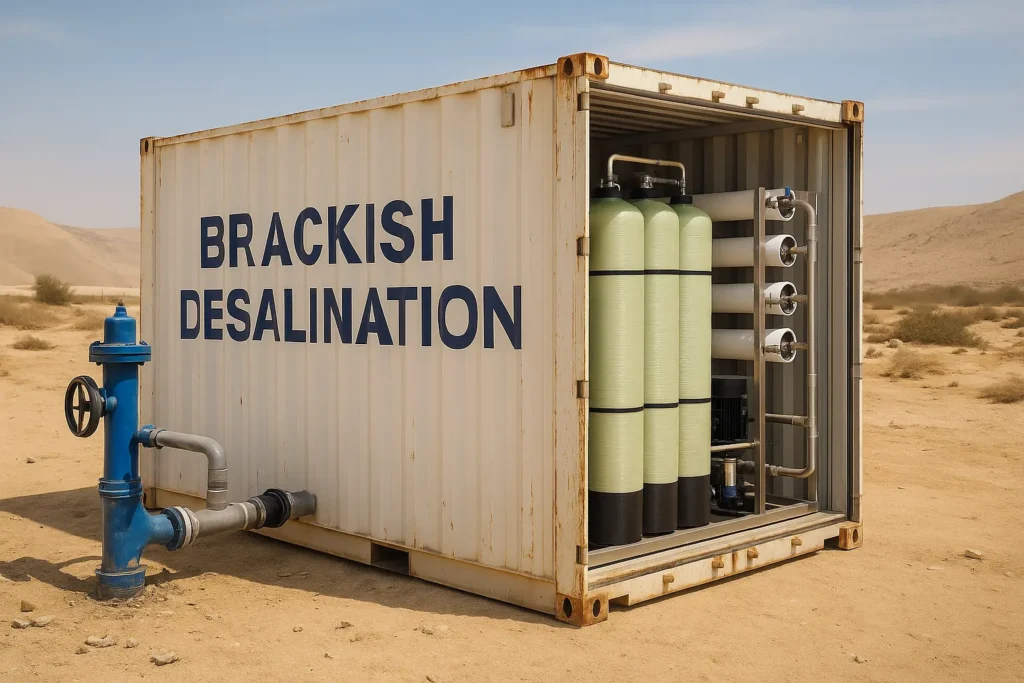Brackish desalination turns saline groundwater and inland sources into reliable freshwater. Compared with seawater, brackish feeds typically need lower pressure and can run higher recovery—cutting energy and OPEX when engineered correctly. This guide explains what counts as brackish, how to choose among RO, NF and EDR, what pretreatment and scaling controls you need, and how to size and accept a plant with confidence. If you already know what you need, browse our systems: Brackish RO Water Systems →
What Counts as Brackish Water?
Most agencies define brackish water as having 1,000–10,000 mg/L TDS—saltier than freshwater, far below seawater (>35,000 mg/L). In practice, the composition matters as much as TDS: hardness, silica, iron/manganese, organics and temperature all influence design, recovery and maintenance.

This chemistry-first view is essential for successful brackish desalination in inland wells.
When Should You Desalinate Brackish Sources?
- Taste & corrosion: High TDS and chloride can damage networks and fixtures.
- Regulatory limits: Local drinking/process-water standards require TDS or ion-specific reduction.
- Process quality: Boilers, cooling, food & beverage, microelectronics need lower hardness/ions.
- Blending constraints: Limited low-TDS make-up makes blending impractical.
Process Options: RO, NF and EDR
Each technology excels under different chemistry and operating constraints. Use the matrix below to shortlist:
| Criterion | RO (Reverse Osmosis) | NF (Nanofiltration) | EDR (Electrodialysis Reversal) |
|---|---|---|---|
| Main removal | Broad ions & organics (lowest permeate TDS) | Divalent ions & partial salts (softening + partial desal) | Dissolved salts (monovalent/divalent), chlorine tolerant |
| Typical brackish use | Universal choice; highest salt rejection | Reduce hardness/TDS to moderate levels; raise RO recovery | Low-turbidity wells, silica manageable, stable feeds |
| エネルギー | Low–moderate vs SWRO (pressure driven) | Low (lower ΔP than RO) | Low–moderate (voltage driven) |
| Fouling tolerance | Sensitive to organics/colloids; needs SDI control | Similar to RO (less stringent pressure) | Generally robust; polarity reversal helps cleaning |
| 備考 | Best permeate quality; widely available membranes | Great as a front end to improve RO economics | Attractive when hardness/chlorine present and turbidity is low |
経験則だ: Start with RO for most projects. Consider NF as a front-end when hardness/sulfate is high or when higher recovery is needed. Consider EDR when brackish feed is clear (low turbidity), chlorine is desirable for bio-control, and TDS reduction rather than ultra-low permeate is the goal.In most municipal and resort projects, brackish desalination with RO delivers the best balance of recovery, energy and permeate quality.
Pretreatment & Scaling Control
- Particles & organics: 50 → 5 µm staged filtration; optional multimedia or UF; carbon for taste/TOC (where needed).
- Iron & manganese: Oxidation + media (greensand/pyrolusite) or sequestration; protect membranes and EDR stacks.
- Silica & hardness: Antiscalant dosing, pH control; consider NF front-end where silica is persistent.
- Monitoring: SDI/NTU targets; online ΔP by stage; feed/permeate conductivity & temperature; event/alarm logs.
- Good practice: Auto-flush on shutdown; lay-up preservatives for long idle periods.
Recovery Targets & Concentrate Management
Brackish plants commonly run higher recovery than seawater when scaling is controlled. Start conservatively during commissioning, then optimize. Think early about concentrate routes: evaporation ponds (arid sites), deep-well injection, permitted discharge/blending, or brine minimization (high-recovery RO, thermal, or crystallization) where required.Plan concentrate routes early—it’s part of total lifecycle cost for any brackish desalination project.

Sizing Basics for Brackish Desalination
(with a Quick Example)
Sizing must consider demand, temperature, feed chemistry and target quality. Use this quick approach for a desktop estimate:
- Daily permeate (m³/d) from users and processes; add 15–25% buffer.
- Pick technology (RO/NF/EDR) from the matrix above and feed chemistry.
- Estimate recovery (e.g., 60–80% for many brackish RO projects, chemistry permitting).
- エネルギー (RO) often falls in the single-digit kWh/m³; colder feeds raise energy.
Worked example — inland resort
200 guests, 180 L/person/day ⇒ 36 m³/d. Add 20% buffer ⇒ ~43 m³/d. Feed TDS 3,000 mg/L at 20 °C, low iron/manganese, moderate silica.
Choose RO with antiscalant; start at 70% recovery and optimize after baseline logging. Select a 50–60 m³/d skid to cover temperature swings and maintenance.
Materials & Automation
- Wetted parts: 304/316L pipework; FRP or 8040 pressure vessels; EPDM/Viton seals per chemistry.
- Pumps & VFD: Brackish-rated HP pump; VFD control for energy and flow stability.
- Electrical: IP54/55 enclosure; E-stop; alarms; historian or data logging for KPIs.
- Labelling: Inlet/Permeate/Concentrate/CIP clearly marked for safe operation.
Acceptance & Documentation (FAT/SAT)
- Witness tests: feed/permeate flows, conductivity, recovery, specific energy, ΔP by stage at design temperature.
- Control logic: interlocks, auto-flush, lay-up routines, permissives and trips.
- Handover: GA, P&ID, IOM, spares list, commissioning & water test logs.
Ready to size a unit? Explore our portfolio: Brackish RO Systems · Accessories: Guard Filter Cartridges, Membrane Housings, Stainless-Steel Tanks.
Case Snapshot — Inland Wellfield (Quick Notes)
- Feed: 2,500–3,200 mg/L TDS, seasonal temperature 12–26 °C.
- Plant: Two parallel RO trains, 5 µm guard filters, antiscalant dosing, UV.
- Results: Baseline recovery 70% → optimized to 78% after 60 days; stable permeate <100 mg/L TDS; ΔP trending enabled predictive CIP.
よくあるご質問
- What TDS range is “brackish”?
- Typically 1,000–10,000 mg/L. Composition (hardness, silica, iron/manganese) still drives design and recovery.
- Is brackish desalination cheaper to run than seawater?
- Generally yes: lower pressure and higher recovery are achievable when scaling is managed.
- When would I pick EDR instead of RO?
- When feed is low-turbidity, chlorine tolerance is desired, and target quality does not require ultra-low TDS. EDR can be robust and efficient in the right chemistry.
- What about concentrate disposal inland?
- Common routes include evaporation ponds, deep-well injection, permitted discharge or advanced brine minimization.
- Can I combine NF with RO?
- Yes. NF can reduce hardness/sulfate and improve RO recovery and economics on certain brackish feeds.
Ready to size a unit? Explore our portfolio: Brackish desalination systems

